Inflight Magazine of Brussels Airlines
Welcome to the Inflight Magazine of Brussels Airlines
The Sibelius trail
 With an ambitious new concert hall due to open in Helsinki next year, Jean Sibelius is at the forefront of people’s minds once again. Kieran Falconer follows in the footsteps of Finland’s greatest composer
With an ambitious new concert hall due to open in Helsinki next year, Jean Sibelius is at the forefront of people’s minds once again. Kieran Falconer follows in the footsteps of Finland’s greatest composer
No composer has ever been associated so closely with his native land as Jean Sibelius. During his lifetime his music became inextricably linked with the rise of nationalism, and when Finland finally achieved independence from Russia in 1917, his position as an icon was assured. You can’t escape his name in Helsinki, where streets and cafés are named after his most famous works. In fact, it’s possible to trace the trajectory of his life without venturing very far beyond the city limits.
Visit his birthplace
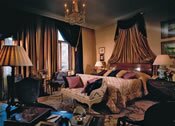 Just 100km north of Helsinki, in the small town of Hämeenlinna, a doctor delivered his own son on 8 December 1865. The boy was absent-minded and not particularly scholarly, but he adored music. Hämeenlinna is a pretty place with many parks, and the town slips almost imperceptibly into countryside. Music must have filled Sibelius’ mind because, in old age, he remembered walking into the nearby woods and thinking of the landscape as his orchestra: the crows were oboes, the thrushes were violins and the pine thrushes were the flutes.
Just 100km north of Helsinki, in the small town of Hämeenlinna, a doctor delivered his own son on 8 December 1865. The boy was absent-minded and not particularly scholarly, but he adored music. Hämeenlinna is a pretty place with many parks, and the town slips almost imperceptibly into countryside. Music must have filled Sibelius’ mind because, in old age, he remembered walking into the nearby woods and thinking of the landscape as his orchestra: the crows were oboes, the thrushes were violins and the pine thrushes were the flutes.
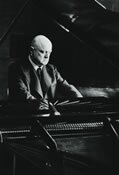 Located in the centre of Hämeenlinna, Sibelius’ childhood home (11 Hallituskatu, hameenlinna.fi), a sandy yellow clapboard house filled with typical Victoriana, is now open to the public.
Located in the centre of Hämeenlinna, Sibelius’ childhood home (11 Hallituskatu, hameenlinna.fi), a sandy yellow clapboard house filled with typical Victoriana, is now open to the public.
Sibelius left home to study law in Helsinki, but when they discovered that he didn’t go to lectures, take any exams or even open a law book, his family allowed him to study music. With a slightly more interesting crowd around him, he soon discovered the delights of brandy and cigars. After university, he took up teaching music, but found it so boring that, if the weather was good, he just let his students go outside in the sun.
Drink at his club
 Hotel Kämp (29 Pohjoisesplanadi, , hotelkamp.fi) was – and still is – the height of style in Helsinki. This is where, in the late 19th century, Sibelius and his friends formed the Symposium, a ‘drinking and thinking’ club. Certainly a lot of drinking went on – a painting by member Akseli GallenKallela shows the boys in a heavy-eyed stupor with bottles on the table.
Hotel Kämp (29 Pohjoisesplanadi, , hotelkamp.fi) was – and still is – the height of style in Helsinki. This is where, in the late 19th century, Sibelius and his friends formed the Symposium, a ‘drinking and thinking’ club. Certainly a lot of drinking went on – a painting by member Akseli GallenKallela shows the boys in a heavy-eyed stupor with bottles on the table.
Fuelled by Swedish punch, Benedictine liqueur and cigars, sessions in the salon could go on for days. Once they all took exception to the style of the fireplace and decided to rebuild it. It cost them the equivalent of thousands of euros in damages. On another occasion, a violinist friend left them to play in an orchestra in St Petersburg. When he returned the next day, they were still in the same chairs. They asked him if he’d gone to the lavatory.
Sibelius said: “The waves of our conversations rose sky high. We reflected on everything from earth to heaven, ideas sparkled, problems got inflamed, but always in a positive, liberating spirit.” The setting did seem to provide inspiration. It was here that Sibelius, light headed on quinine, started tapping out a tune with his fingers that would later become the beginning of Valse Triste. The hotel has recently been renovated and is now part of the Starwoods group.
Walk through his park
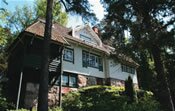 Just north of the centre of Helsinki is Sibelius Park (between Merikannontie and Mechelininkatu). Named after the composer on his 80th birthday in 1945, it was graced some 20 years later by Eila Hiltunen’s Sibelius Monument sculpture. Looking like something Sibelius and his mates would have knocked up after a good case of brandy, the monument consists of hundreds of metal tubes of different sizes clinging together like a clumsy rocket. Unsurprisingly, this caused such invective in the press that a bust of Sibelius was later added to appease traditionalists.
Just north of the centre of Helsinki is Sibelius Park (between Merikannontie and Mechelininkatu). Named after the composer on his 80th birthday in 1945, it was graced some 20 years later by Eila Hiltunen’s Sibelius Monument sculpture. Looking like something Sibelius and his mates would have knocked up after a good case of brandy, the monument consists of hundreds of metal tubes of different sizes clinging together like a clumsy rocket. Unsurprisingly, this caused such invective in the press that a bust of Sibelius was later added to appease traditionalists.
See his final resting place
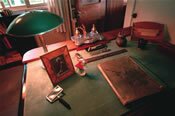 Thirty minutes drive north of Helsinki, on the shores of Lake Tuusula in Järvenpää, is a small timber-framed villa. This is Ainola (ainola.fi). Named after his wife Aino, it was Sibelius’ home for more than 50 years until his death in 1957.
Thirty minutes drive north of Helsinki, on the shores of Lake Tuusula in Järvenpää, is a small timber-framed villa. This is Ainola (ainola.fi). Named after his wife Aino, it was Sibelius’ home for more than 50 years until his death in 1957.
After so many distractions in the capital, Finnish nature spoke to him. “In Helsinki, all music dies in me,” he said, and it was here that he found the peace to write his last four symphonies, the violin concerto and countless orchestral works. The house itself retains its charming interior, with ‘50s furniture and wood-panelled walls. His study is kept as if he’d just popped out, walking stick and Borsalino hat on a side table. The library still has that scent of cigars. The dining room has an impressive green-tiled fireplace. Sibelius was a synesthete who saw music in terms of colour, and green was the key of F.
It was here that he became penitent and finally apologised to his wife for being such a bad spouse. During his last illness, he was ordered to stay bedridden but got up, picked her some wild flowers and asked her again to marry him. On the south side of the garden, underneath the apple trees, sit the bronze gravestones of both Jean and Aino Sibelius.
Where to hear Sibelius
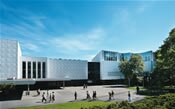 *The imposing Finlandia Hall (13 Mannerheimintie, finlandiatalo.fi) overlooks Töölönlahti Bay, its white Carrara marble shining out on a sunny day, making it resemble a beached iceberg. Home to the Helsinki Philharmonic Orchestra, it also hosts visiting orchestras and has a regular programme of events.
*The imposing Finlandia Hall (13 Mannerheimintie, finlandiatalo.fi) overlooks Töölönlahti Bay, its white Carrara marble shining out on a sunny day, making it resemble a beached iceberg. Home to the Helsinki Philharmonic Orchestra, it also hosts visiting orchestras and has a regular programme of events.
*Likewise, the Finnish National Opera (58 Helsinginkatu, operafin.fi) has free foyer music as well as a regular opera and ballet.
*But the next big thing is, at present, a large hole in the city centre just in front of the Parliament. This ambitious project will be the Musiikkitalo (Helsinki Music Centre, musiikkitalo.fi), a concert hall that will stage music from the Finnish Radio Symphony Orchestra, the Helsinki Philharmonic and the Sibelius Academy – the only music university in Finland. It’s set to open in 2010.
*See Helsinki Tourist Office at hel2.fi. tourism, or visitfinland.com, for more details.
FR Sur les traces de Sibelius
À l’aube de l’ouverture d’une nouvelle salle de concert à Helsinki, un projet ambitieux prévu pour l’année prochaine, Jean Sibelius revient à nouveau au- devant de la scène. Kieran Falconer marche dans les pas du plus grand compositeur finlandais
Visitez sa ville natale
Située dans le centre d’Hämeenlinna, une charmante petite ville, la maison natale de Sibelius est une demeure en bois de couleur jaune sable, meublée dans un style typiquement Victorien. La campagne environnante était sa source d’inspiration ; plus tard dans sa vie, il se souvient avoir eu une vision, la campagne étant son orchestre ; les corneilles étaient des hautbois, les grives des violons.
Prenez un verre dans son club
L’hôtel Kämp (29 Pohjoisesplanadi, tél. 8 , hotelkamp.fi) était le lieu du Symposium, un club ‘de boisson et de réflexion’ mis sur pied par Sibelius. Alimentées par le punch suédois et la liqueur Bénédictine, les réunions pouvaient durer des jours entiers dans le salon. Quoiqu’il en soit cet endroit s’avéra inspirant pour Sibelius, qui y a composé le début de la Valse Triste, alors qu’il était étourdi sous les effets de la quinine.
Promenez-vous dans son parc
Au nord du centre d’Helsinki se trouve le Parc Sibelius. Baptisé du nom du compositeur lors de son 80ème anniversaire en 1945, le parc a reçu 20 ans plus tard le Mémorial Sibelius, sculpture d’Eila Hiltunen. Réalisé à partir de centaines de tubes en métal, ce monument controversé a causé tant de discordes qu’un buste de Sibelius a été ajouté par la suite.
Découvrez sa dernière demeure
À 30 minutes de route au nord d’Helsinki, sur les rives du lac Tuusula, se trouve Ainola (ainola.fi), la demeure de Sibelius jusqu’à sa mort en 1957. Son bureau est entièrement conservé, comme s’il venait juste de sortir, laissant sa canne et son Borsalino sur le coin de la table. Dans la bibliothèque, une odeur de cigare flotte toujours dans l’air. Un feu ouvert recouvert de carrelages verts trône dans la salle à manger ; Sibelius était un ‘synesthète’ qui voyait le son comme une couleur. Le vert était la clé de Fa. Sa pierre tombale en bronze repose sous les pommiers du jardin.
Où aller écouter Sibelius
Salle de concert Finlandia (13 Mannerheimintie, finlandiatalo.fi) Opéra National de Finlande (58 Helsinginkatu, operafin.fi) Le Musiikkitalo (Centre Musical d’Helsinki, musiikkitalo.fi) – dont l’ouverture est prévue en 2010.
NL In het spoor van Sibelius
Nu er volgend jaar in Helsinki een ambitieuze nieuwe concertzaal opengaat, heeft Jean Sibelius opnieuw een vooraanstaand plekje veroverd in de hoofden van heel wat mensen. Kieran Falconer volgt in het spoor van de grootste componist die Finland ooit gekend heeft.
Bezoek zijn geboortedorp Het huis waarin Sibelius is opgegroeid, ligt pal in het centrum van Hämeenlinna, een prettig ogend dorp. Zijn geboortehuis is een zanderig gele woning met dakspanen, binnenin ingericht met typisch Victoriaanse toetsen. Het omliggende platteland was voor de componist een bron van inspiratie. Toen hij al een oude man was, vertelde hij dat voor hem het landschap zijn orkest was. De kraaien waren zijn hobo’s en de lijsters zijn violen.
Ga een glas drinken in zijn clubhuis Hotel Kämp (29 Pohjoisesplanadi, , hotelkamp.fi) maakte deel uit van het Symposium. Het was een ‘drink- en denkclub’, opgericht door Sibelius. Met Zweedse punch en Benedictijnse likeur als brandstof, bracht hij er soms dagenlang door in het gezelschap van gelijkgestemde zielen. Het decor was ook daadwerkelijk een bron van inspiratie: Sibelius componeerde er het begin van Valse Triste terwijl hij stevig onder de invloed was van kinine.
Kuier rond in zijn park Net ten noorden van het centrum van Helsinki ligt Sibelius Park. Het park werd in 1945 op de 80e verjaardag van de componist naar hem genoemd. Twintig jaar later volgde het Sibelius Memorial standbeeld van Eila Hiltunen. Het gedenkteken is opgebouwd uit honderden metalen buizen. Het controversiële monument lokte zoveel commotie uit dat er later een buste van Sibelius werd bijgezet.
Ga hem begroeten aan zijn laatste rustplaats Op zo’n dertig minuten rijden ten noorden van Helsinki, aan de kust van Tuusula, staat Ainola (ainola.fi), het huis waarin Sibelius leefde tot aan zijn dood in 1957. Zijn studiekamer is onaangeroerd bewaard gebleven. Het lijkt wel of hij er elke minuut kan komen binnenwandelen. Zijn wandelstok en Borsalino hoed liggen er nog op het bijzettafeltje. In de bibliotheek hangt nog steeds een sigarengeur. In de eetkamer staat een groenbetegelde open haard; Sibelius was een synestheet, hij ervoer geluiden als kleuren. Zo was groen voor hem overduidelijk de muzieknoot fa. Zijn bronskleurige grafsteen ligt er in de tuin onder appelbomen.
Waar kan je het werk van Sibelius beluisteren? Finlandia Hall (13 Mannerheimintie, finlandiatalo.fi) Finse Nationale Opera (58 Helsinginkatu, operafin.fi)
De Musiikkitalo (Het Muziekcentrum van Helsinki, musiikkitalo.fi) – de opening is gepland voor 2010.
Leave a Reply
